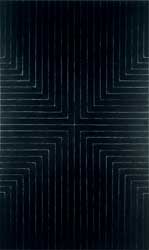Minimalism (visual arts) facts for kids
Minimalism is a style found in different types of art and design, especially visual art and music. It focuses on showing only the most important parts of something by removing anything extra or unnecessary. As an art movement, Minimalism became popular after World War II, especially in American visual arts during the 1960s and early 1970s. Many people see Minimalism as a response to abstract expressionism and a step towards newer art styles. Some famous artists linked to this movement include Ad Reinhardt, Donald Judd, Agnes Martin, Dan Flavin, and Frank Stella. Artists sometimes didn't like the "minimalism" label because it made their work sound too simple.
Contents
History of Minimal Art
Minimal art, also called "literalist art" or "ABC Art," first appeared in New York in the early 1960s. At this time, both new and experienced artists started exploring geometric abstraction. This meant using simple shapes and lines. Some artists like Frank Stella and Ellsworth Kelly explored this in painting. Others like Sol LeWitt, Carl Andre, and Donald Judd worked with sculpture.
Important art galleries in New York, such as the Green Gallery and the Leo Castelli Gallery, began to show these new geometric artworks. There were also two very important museum exhibitions in 1966. One was Primary Structures: Younger American and British Sculpture at the Jewish Museum. The other was Systemic Painting at the Solomon R. Guggenheim Museum. These shows helped the art world recognize the new minimal art movement.
Minimalism also has roots in European art. It was influenced by the geometric art of the Bauhaus school, and artists like Kazimir Malevich and Piet Mondrian from the De Stijl movement. The Russian Constructivist movement and the sculptor Constantin Brâncuși also played a role. Minimal art was also partly inspired by painters like Barnett Newman and Josef Albers. It was also a reaction against the emotional and expressive style of abstract expressionism, which was popular in New York during the 1940s and 1950s.
Minimalist Paintings
Unlike the abstract expressionists who came before them, some minimalist painters clearly stated that their art was not about showing personal feelings. They wanted their art to be "objective," meaning it was based on facts and not emotions.
Generally, minimalist paintings used geometric shapes, often like cubes. They removed most hidden meanings, made all parts equal, repeated elements, used plain surfaces, and sometimes used industrial materials.
One of the first artists known for minimalism was the painter Frank Stella. His early "pinstripe" paintings, sometimes called the Black Paintings, were shown in 1959 at the Museum of Modern Art in New York. The width of the stripes in Stella's paintings was decided by the size of the wood used to stretch the canvas. This meant the design on the canvas wasn't just a personal choice. It was partly based on the physical structure of the painting itself. Artist Carl Andre wrote about Stella's work, saying, "Art excludes the unnecessary. Frank Stella has found it necessary to paint stripes. There is nothing else in his painting." These simple works were very different from the energetic and emotional paintings of artists like Willem de Kooning. Instead, they were more like the calmer, color field paintings of Barnett Newman and Mark Rothko.
Single-Color Paintings

Painting with just one color, known as monochrome painting, has a long history. It started in Paris in 1882 with a black painting by the poet Paul Bilhaud. Later, in the 1880s, writer Alphonse Allais showed other single-color paintings, like a white one called First communion of anaemic young girls in the snow. However, these early examples were more like playful art movements such as Dada than the serious monochrome paintings that came later.
Yves Klein began painting monochromes as early as 1949. He had his first public display of this work in 1954.
Ad Reinhardt created paintings that were almost entirely black. He believed in a simple approach to art. He wrote, "The more stuff in it, the busier the work of art, the worse it is. More is less. Less is more." He felt that art should get rid of anything extra. Reinhardt's idea was very different from what artist Hans Hofmann believed. Hofmann thought nature was the main source of his abstract paintings.
Art as Specific Objects

Minimal art often moved away from creating pictures or illusions. Instead, it focused on being "literal," meaning the art was simply what it was. This led to a shift from painting to creating sculptures or "objects."
Donald Judd started as a painter but became known for making objects. His important essay, "Specific Objects" (published in 1965), helped shape the ideas behind minimalist art. In this essay, Judd suggested a new direction for American art, moving away from older European art ideas. He saw this new direction in the works of artists like Jasper Johns and Dan Flavin. Judd was especially interested in the work of George Earl Ortman, who made simple, strong, geometric shapes. These "specific objects" didn't fit neatly into categories like painting or sculpture. For Judd, the fact that these objects questioned what art could be, and avoided old art rules, made them valuable.
See also
- Minimalism
- List of minimalist artists
- Maximalism




